Abstract
The disposition of, and pharmacological response to, a single intravenous dose of vitamin K1 (10 mg) was studied in eleven patients on daily warfarin therapy. The pharmacokinetics of vitamin K1 in patients were similar to those reported previously in healthy volunteers, terminal half-life 1.7 h. All patients had been taking warfarin for at least 3 months. Steady state warfarin plasma concentrations ranged from 0.5 to 1.4 micrograms ml-1. Prothrombin complex activity ranged from 15 to 28.5%. There was considerable inter-individual variation in pharmacodynamic response as expressed by prothrombin complex activity (PCA) and Factor VII. The maximum values for PCA and Factor VII were reached at 24-96 h and 24-48 h, respectively, after the administration of vitamin K1. Vitamin K1 (10 mg) has a long duration of action (greater than 168 h) in terms of clotting factor synthesis in patients on steady state warfarin. All the patients on warfarin had measurable levels (CPmax 0.3-1.2 micrograms ml-1) of vitamin K1 2, 3-epoxide. There was a significant correlation between the pharmacodynamic response as expressed by change in % PCA and the AUC for vitamin K1 2,3-epoxide (P less than 0.05).
Full text
PDF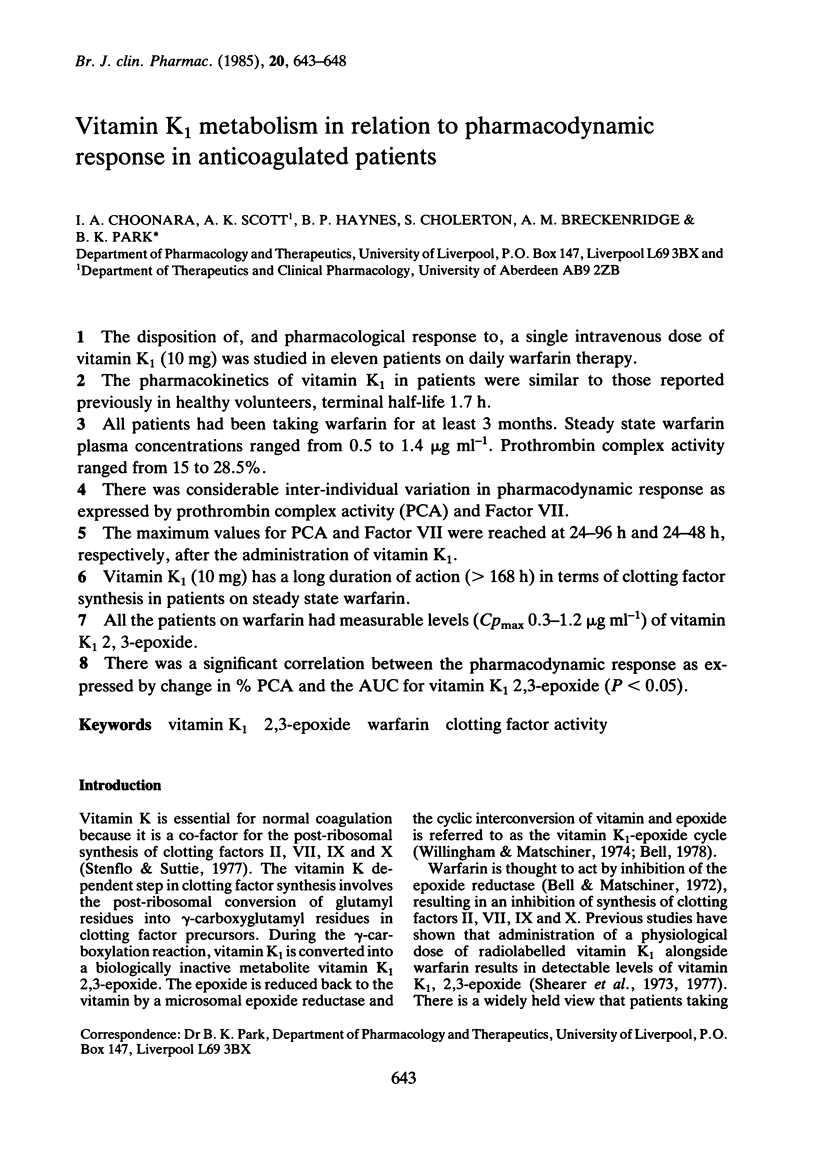
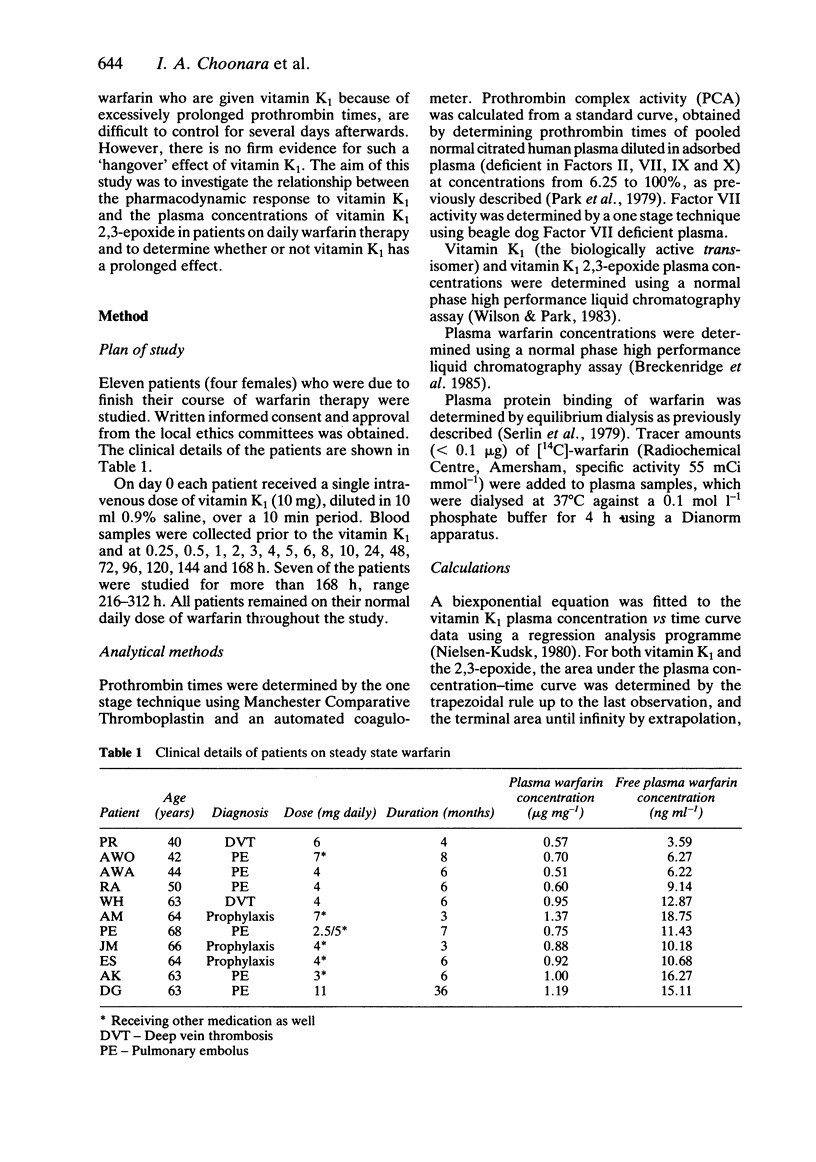
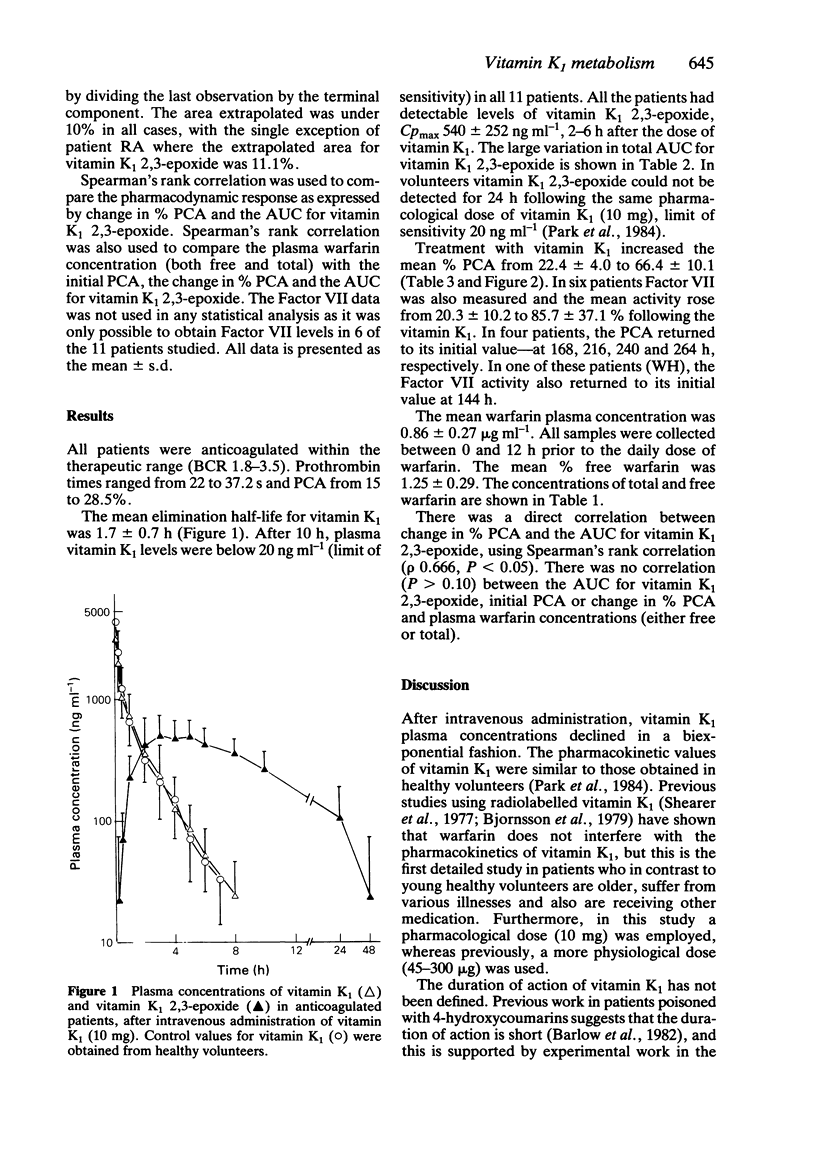
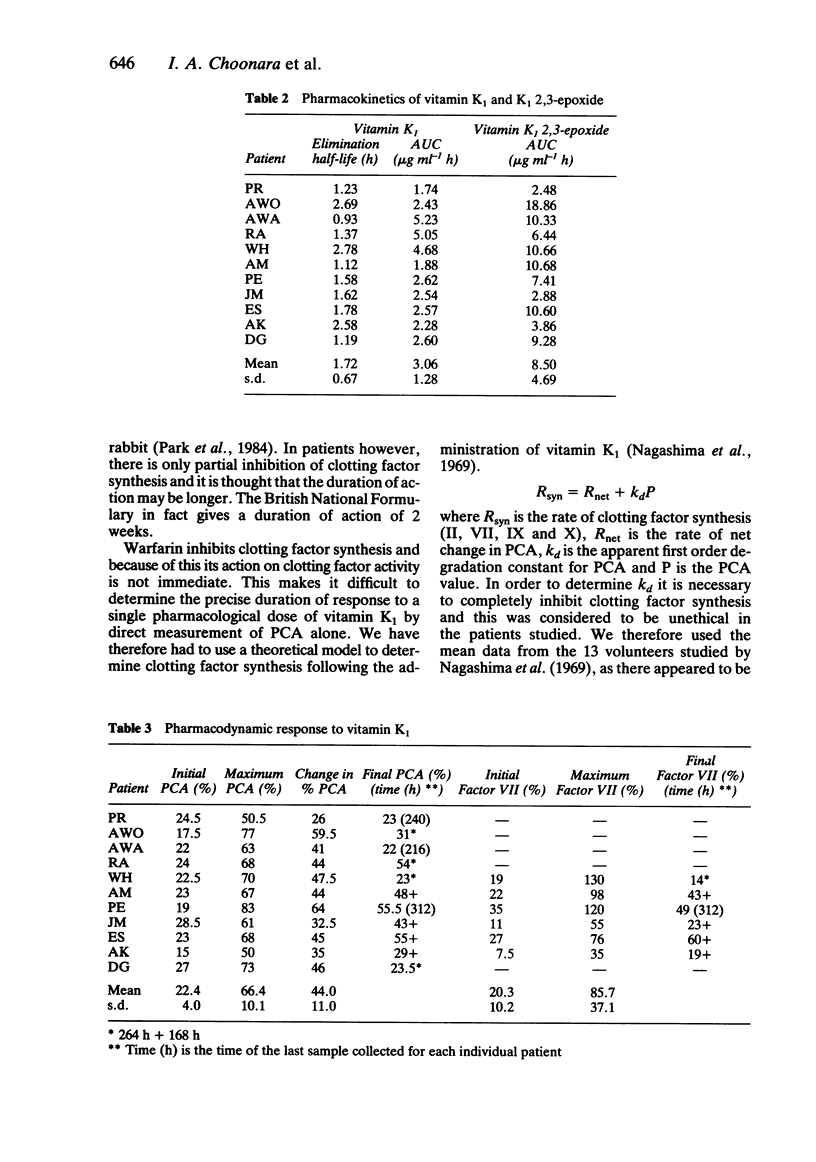
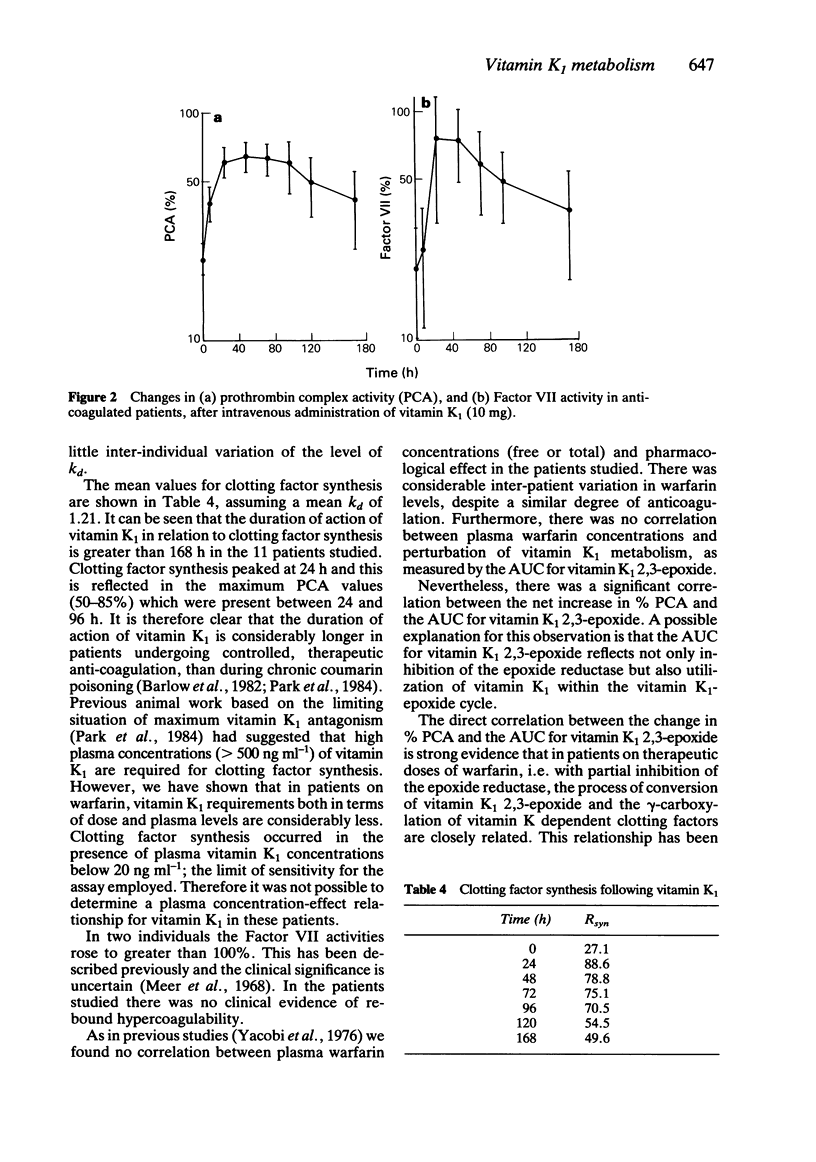
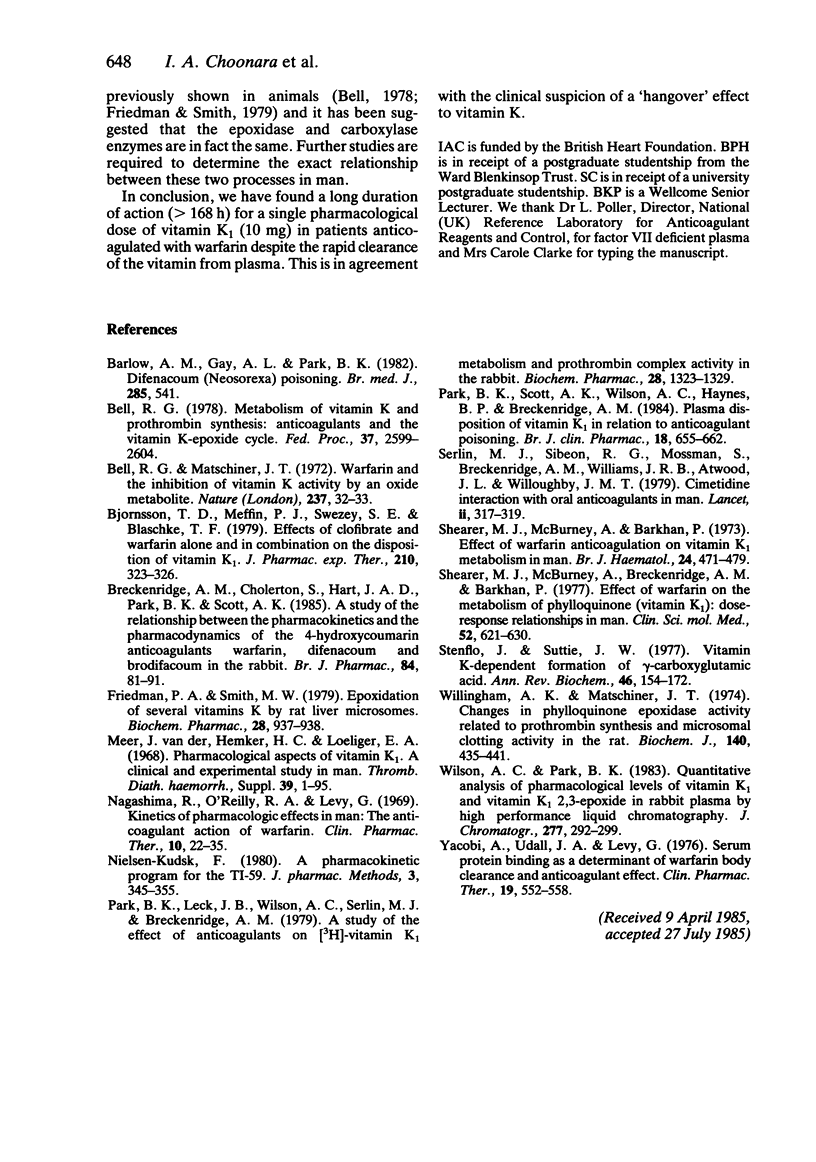
Selected References
These references are in PubMed. This may not be the complete list of references from this article.
- Barlow A. M., Gay A. L., Park B. K. Difenacoum (Neosorexa) poisoning. Br Med J (Clin Res Ed) 1982 Aug 21;285(6341):541–541. doi: 10.1136/bmj.285.6341.541. [DOI] [PMC free article] [PubMed] [Google Scholar]
- Bell R. G., Matschiner J. T. Warfarin and the inhibition of vitamin K activity by an oxide metabolite. Nature. 1972 May 5;237(5349):32–33. doi: 10.1038/237032a0. [DOI] [PubMed] [Google Scholar]
- Bell R. G. Metabolism of vitamin K and prothrombin synthesis: anticoagulants and the vitamin K--epoxide cycle. Fed Proc. 1978 Oct;37(12):2599–2604. [PubMed] [Google Scholar]
- Bjornsson T. D., Meffin P. J., Swezey S. E., Blaschke T. F. Effects of clofibrate and warfarin alone and in combination on the disposition of vitamin K1. J Pharmacol Exp Ther. 1979 Sep;210(3):322–326. [PubMed] [Google Scholar]
- Breckenridge A. M., Cholerton S., Hart J. A., Park B. K., Scott A. K. A study of the relationship between the pharmacokinetics and the pharmacodynamics of the 4-hydroxycoumarin anticoagulants warfarin, difenacoum and brodifacoum in the rabbit. Br J Pharmacol. 1985 Jan;84(1):81–91. [PMC free article] [PubMed] [Google Scholar]
- Friedman P. A., Smith M. W. Epoxidation of several vitamins K by rat liver microsomes. Biochem Pharmacol. 1979 Mar 15;28(6):937–938. doi: 10.1016/0006-2952(79)90379-4. [DOI] [PubMed] [Google Scholar]
- Nagashima R., O'Reilly R. A., Levy G. Kinetics of pharmacologic effects in man: the anticoagulant action of warfarin. Clin Pharmacol Ther. 1969 Jan-Feb;10(1):22–35. doi: 10.1002/cpt196910122. [DOI] [PubMed] [Google Scholar]
- Nielsen-Kudsk F. A pharmacokinetic program for TI-59. J Pharmacol Methods. 1980 Jun;3(4):345–355. doi: 10.1016/0160-5402(80)90076-5. [DOI] [PubMed] [Google Scholar]
- Park B. K., Leck J. B., Wilson A. C., Serlin M. J., Breckenridge A. M. A study of the effect of anticoagulants on [3H]vitamin K1 metabolism and prothrombin complex activity in the rabbit. Biochem Pharmacol. 1979 Apr 15;28(8):1323–1329. doi: 10.1016/0006-2952(79)90433-7. [DOI] [PubMed] [Google Scholar]
- Park B. K., Scott A. K., Wilson A. C., Haynes B. P., Breckenridge A. M. Plasma disposition of vitamin K1 in relation to anticoagulant poisoning. Br J Clin Pharmacol. 1984 Nov;18(5):655–662. doi: 10.1111/j.1365-2125.1984.tb02526.x. [DOI] [PMC free article] [PubMed] [Google Scholar]
- Serlin M. J., Sibeon R. G., Mossman S., Breckenridge A. M., Williams J. R., Atwood J. L., Willoughby J. M. Cimetidine: interaction with oral anticoagulants in man. Lancet. 1979 Aug 18;2(8138):317–319. doi: 10.1016/s0140-6736(79)90340-4. [DOI] [PubMed] [Google Scholar]
- Shearer M. J., McBurney A., Barkhan P. Effect of warfarin anticoagulation on vitamin-K 1 metabolism in man. Br J Haematol. 1973 Apr;24(4):471–479. doi: 10.1111/j.1365-2141.1973.tb01673.x. [DOI] [PubMed] [Google Scholar]
- Shearer M. J., McBurney A., Breckenridge A. M., Barkhan P. Effect of warfarin on the metabolism of phylloquinone (vitamin K1):dose-response relationships in man. Clin Sci Mol Med. 1977 Jun;52(6):621–630. doi: 10.1042/cs0520621. [DOI] [PubMed] [Google Scholar]
- Stenflo J., Suttie J. W. Vitamin K-dependent formation of gamma-carboxyglutamic acid. Annu Rev Biochem. 1977;46:157–172. doi: 10.1146/annurev.bi.46.070177.001105. [DOI] [PubMed] [Google Scholar]
- Willingham A. K., Matschiner J. T. Changes in phylloquinone epoxidase activity related to prothrombin synthesis and microsomal clotting activity in the rat. Biochem J. 1974 Jun;140(3):435–441. doi: 10.1042/bj1400435. [DOI] [PMC free article] [PubMed] [Google Scholar]
- Wilson A. C., Park B. K. Quantitative analysis of pharmacological levels of vitamin K1 and vitamin K1 2,3-epoxide in rabbit plasma by high-performance liquid chromatography. J Chromatogr. 1983 Oct 14;277:292–299. doi: 10.1016/s0378-4347(00)84847-1. [DOI] [PubMed] [Google Scholar]
- Yacobi A., Udall J. A., Levy G. Serum protein binding as a determinant of warfarin body clearance and anticoagulant effect. Clin Pharmacol Ther. 1976 May;19(5 Pt 1):552–558. doi: 10.1002/cpt1976195part1552. [DOI] [PubMed] [Google Scholar]


